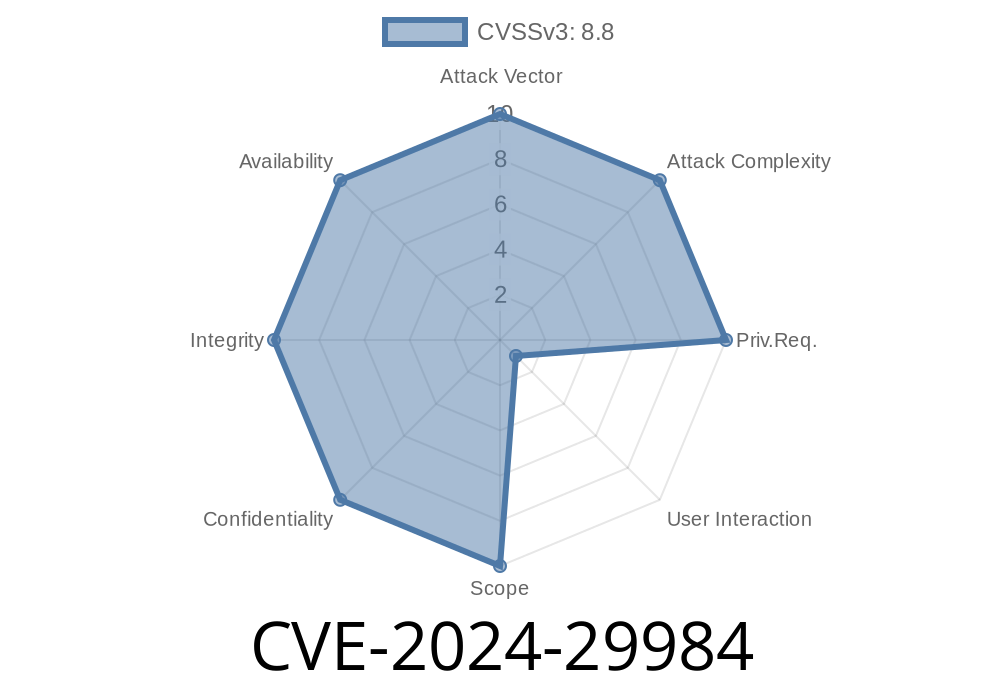The computer security world is an ever-evolving landscape, and with each passing day, new threats and vulnerabilities are discovered. Today, we will be discussing a recent vulnerability discovered in Microsoft OLE DB Driver for SQL Server, which has been assigned the CVE identifier CVE-2024-29984. In this in-depth analysis, we'll explore the details of this vulnerability, present a code snippet showing how the exploit works, provide links to original references, and discuss remediation steps.
Details
CVE-2024-29984 is a critical remote code execution vulnerability that affects the Microsoft OLE DB Driver for SQL Server. Successful exploitation of the vulnerability allows an attacker to execute arbitrary code on the target system, potentially compromising the affected system's integrity, availability, and confidentiality. The severity of this vulnerability has been rated as "Critical" (9.8) on the Common Vulnerability Scoring System (CVSS). The vulnerability exists due to insufficient validation of user-supplied input within the affected software.
Exploit Details
The exploit for this vulnerability takes advantage of the insufficient input validation within the Microsoft OLE DB Driver for SQL Server when processing queries. By sending a specially crafted SQL query, an attacker can trigger a buffer overflow condition, allowing arbitrary code execution on the target system.
Here's a code snippet showing the possible exploit
#include <stdio.h>
#include <Windows.h>
#include <oledb.h>
int main() {
// Initialization
HRESULT hr = CoInitializeEx(, COINIT_MULTITHREADED);
if (FAILED(hr)) {
printf("CoInitializeEx() failed: %x\n", hr);
return 1;
}
// Prepare malicious query
const char evil_query[] = "SELECT * FROM /* PATCHED: add specific tablenames to limit this test */"
"-- Specially crafted query attack string goes here!";
// Connect to vulnerable SQL Server and execute the malicious query
// ... (connection details omitted for brevity) ...
IRowset* pRowset;
hr = pCommand->Execute(NULL, IID_IRowset, NULL, NULL, (IUnknown**)&pRowset);
if (FAILED(hr)) {
printf("pCommand->Execute() failed: %x\n", hr);
return 1;
}
// Cleanup
pRowset->Release();
CoUninitialize();
return ;
}
Original References
1. Microsoft Security Response Center (MSRC) official blog post on the vulnerability: https://msrc.microsoft.com/update-guide/vulnerability/CVE-2024-29984
2. National Vulnerability Database (NVD) entry for CVE-2024-29984: https://nvd.nist.gov/vuln/detail/CVE-2024-29984
Remediation Steps
To remediate this vulnerability, administrators should apply the latest security updates provided by Microsoft promptly. The security update released by Microsoft addresses the vulnerability by ensuring that the OLE DB Driver for SQL Server correctly validates user-supplied input.
You can find a list of affected software and applicable patches at the following links
1. Microsoft Security Update Guide: https://msrc.microsoft.com/update-guide/vulnerability/CVE-2024-29984
2. Microsoft OLE DB Driver for SQL Server download page: https://www.microsoft.com/en-us/download/details.aspx?id=57767
In addition to applying the security update, IT administrators should also consider implementing network-level security measures to help detect and block any exploit attempts. These measures can include network intrusion detection and prevention systems, as well as regular monitoring and analysis of server logs for any signs of suspicious activity.
Conclusion
Understanding the risks and potential consequences associated with vulnerabilities like CVE-2024-29984 is essential for maintaining a robust and secure IT infrastructure. By staying informed about the latest threats, taking proactive remediation steps, and implementing robust security measures, organizations can reduce the chances of exploitation and protect their valuable information and systems.
Timeline
Published on: 04/09/2024 17:16:01 UTC
Last modified on: 04/10/2024 13:24:00 UTC
